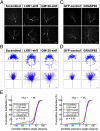Protein kinase LKB1 regulates polarized dendrite formation of adult hippocampal newborn neurons
- PMID: 24367100
- PMCID: PMC3890881
- DOI: 10.1073/pnas.1321454111
Protein kinase LKB1 regulates polarized dendrite formation of adult hippocampal newborn neurons
Abstract
Adult-born granule cells in the dentate gyrus of the rodent hippocampus are important for memory formation and mood regulation, but the cellular mechanism underlying their polarized development, a process critical for their incorporation into functional circuits, remains unknown. We found that deletion of the serine-threonine protein kinase LKB1 or overexpression of dominant-negative LKB1 reduced the polarized initiation of the primary dendrite from the soma and disrupted its oriented growth toward the molecular layer. This abnormality correlated with the dispersion of Golgi apparatus that normally accumulated at the base and within the initial segment of the primary dendrite, and was mimicked by disrupting Golgi organization via altering the expression of Golgi structural proteins GM130 or GRASP65. Thus, besides its known function in axon formation in embryonic pyramidal neurons, LKB1 plays an additional role in regulating polarized dendrite morphogenesis in adult-born granule cells in the hippocampus.
Keywords: Golgi deployment; adult neurogenesis; neuronal polarization.
Conflict of interest statement
The authors declare no conflict of interest.
Figures




Similar articles
-
Repositioning of Somatic Golgi Apparatus Is Essential for the Dendritic Establishment of Adult-Born Hippocampal Neurons.J Neurosci. 2018 Jan 17;38(3):631-647. doi: 10.1523/JNEUROSCI.1217-17.2017. Epub 2017 Dec 7. J Neurosci. 2018. PMID: 29217690 Free PMC article.
-
Differentiation of apical and basal dendrites in pyramidal cells and granule cells in dissociated hippocampal cultures.PLoS One. 2015 Feb 23;10(2):e0118482. doi: 10.1371/journal.pone.0118482. eCollection 2015. PLoS One. 2015. PMID: 25705877 Free PMC article.
-
Reelin and stk25 have opposing roles in neuronal polarization and dendritic Golgi deployment.Cell. 2010 Nov 24;143(5):826-36. doi: 10.1016/j.cell.2010.10.029. Cell. 2010. PMID: 21111240 Free PMC article.
-
Polarized trafficking: the palmitoylation cycle distributes cytoplasmic proteins to distinct neuronal compartments.Curr Opin Cell Biol. 2018 Feb;50:64-71. doi: 10.1016/j.ceb.2018.02.004. Epub 2018 Feb 21. Curr Opin Cell Biol. 2018. PMID: 29475137 Review.
-
Adult neurogenesis in the mammalian dentate gyrus.Anat Histol Embryol. 2020 Jan;49(1):3-16. doi: 10.1111/ahe.12496. Epub 2019 Sep 30. Anat Histol Embryol. 2020. PMID: 31568602 Review.
Cited by
-
Advances in the Signaling Pathways Downstream of Glial-Scar Axon Growth Inhibitors.Front Cell Neurosci. 2020 Jul 2;14:174. doi: 10.3389/fncel.2020.00174. eCollection 2020. Front Cell Neurosci. 2020. PMID: 32714150 Free PMC article. Review.
-
Repositioning of Somatic Golgi Apparatus Is Essential for the Dendritic Establishment of Adult-Born Hippocampal Neurons.J Neurosci. 2018 Jan 17;38(3):631-647. doi: 10.1523/JNEUROSCI.1217-17.2017. Epub 2017 Dec 7. J Neurosci. 2018. PMID: 29217690 Free PMC article.
-
LKB1 Regulates Cerebellar Development by Controlling Sonic Hedgehog-mediated Granule Cell Precursor Proliferation and Granule Cell Migration.Sci Rep. 2015 Nov 9;5:16232. doi: 10.1038/srep16232. Sci Rep. 2015. PMID: 26549569 Free PMC article.
-
Autocrine action of BDNF on dendrite development of adult-born hippocampal neurons.J Neurosci. 2015 Jun 3;35(22):8384-93. doi: 10.1523/JNEUROSCI.4682-14.2015. J Neurosci. 2015. PMID: 26041908 Free PMC article.
-
The organization and function of the Golgi apparatus in dendrite development and neurological disorders.Genes Dis. 2022 Dec 20;10(6):2425-2442. doi: 10.1016/j.gendis.2022.11.009. eCollection 2023 Nov. Genes Dis. 2022. PMID: 37554209 Free PMC article. Review.
References
Publication types
MeSH terms
Substances
LinkOut - more resources
Full Text Sources
Other Literature Sources
Molecular Biology Databases

